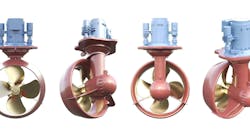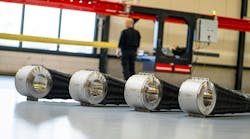Significantly reduced downhole losses
Kim Burrows
David Carbajal
Jeff Kirsner
Bobby Owen
Halliburton
Issues raised by deepwater drilling and changing environmental regulations led to a closer examination of several seem-ingly essential additives for invert emul-sion fluids. Since the introduction of invert emulsion fluids in the 1960s, oil-based fluids (OBFs) and synthetic-based fluids (SBFs) have been formulated with a similar group of components: base oil, organophilic clay and lignite, lime, CaCl2 brine, and emulsifier. The family of invert emulsion fluids has remained closely related in mud properties and performance expectations.
The invert emulsion fluids were developed to help maximize rates of penetration, increase lubricity in directional and horizontal wells, and minimize wellbore stability problems such as those caused by reactive shales. Until operators began drilling in deepwater locations, where the pore pressure/fracture gradient margin is often very narrow, the standard formulations provided satisfactory performance.
Organophilic clay
The most widely used primary viscosifier for OBFs and SBFs is organophilic clay. Organophilic clay is bentonite that has been treated with an amine to make it yield in oil. Organophilic clay, however, requires significant shear and circulating time to yield fully. Overtreatment resulting from this delayed response often causes excessive viscosity, and the problem is compounded when the fluid is at ambient temperature or, worse, is exposed to cold temperatures at the seabed in deepwater locations.
In the early 1980s, the industry acknowledged that controlling OBF rheology is often a "compromise." The goal then, as now, was to develop a fluid that "produces higher gel strengths initially and maintains a relatively flat response to temperature throughout the complete temperature cycle."
Today, virtually all organophilic clays are treated with an amine designed to improve rheological control without creating excessive viscosity. As a result, the clay no longer has the electrical properties of bentonite, but it does retain its plate-like shape and the portion of its shear-thinning properties caused by its shape.
Organophilic clay does not provide viscosity or suspension characteristics in the same way that clay solids do in water-based fluids. In water-based fluids, the addition of commercial bentonite or the introduction of drilled clay solids imparts viscosity as a result of water swelling capabilities and electrical interaction characteristics. In OBFs and SBFs, electrical interaction between particles is minimal, making it difficult to build gel strength or real yield stress in these fluids. Both oil-soluble materials and oil-dispersible colloidal solids tend to increase the overall viscosity rather than the low shear rate viscosity and the real yield stress.
Regulatory changes
Following an environmental impact assessment in 1999, the EPA encouraged the dev-elopment of new esters with lower viscosity. Ester-based fluids used since 1990 in the North Sea demonstrated satisfactory environmental and technical performance. The early ester systems, however, appeared to elevate viscosities at cold temperatures, making them unattractive for use with long risers. A new ester-based fluid was formulated with shorter chain length, low-viscosity C8 esters. In 2000, the fluid was field-tested on a Gulf of Mexico well in 3,669 ft of water. Data from the pressure-while-drilling (PWD) tool demonstrated that the fluid did not cause high equivalent circulating densities (ECDs) even when exposed to chilly riser temperatures.
null
Five months after a project launched to re-engineer the ester-based SBF system, the results were the greatest step-change in OBF technology in 40 years. Using an ester-internal olefin (IO) blend as the base fluid helped provide desirable environmental and performance characteristics. To make the emulsion-based system perform acceptably, the system developed several new products and reformulated some additives used in conventional SBFs.
null
Clay-free SBF field trial
The system was introduced in the GoM in Green Canyon at a water depth of 3,669 ft. Flowline temperatures ranging from 42° F to 72° F were recorded. The interval was initially begun with a 9.2-lb/gal IO SBF and then gradually converted to the system by adding the ester/IO blend base oil.
When the conversion was completed, improved rheology control was clearly apparent, and PWD data indicated significantly lower ECDs and a greater margin of wellbore stability. Throughout the well, there was no evidence of loss of suspension or barite sag.
Field trial evidence indicated that the system would surpass both the environmental and rheological hurdles and provide unexpected additional benefits.
Barite sag
Barite sag can occur in wells with a deviation of 30° or more, and is likely to be most pronounced in high-angle wells with a 60-75° inclination. The fact that barite sag can lead to loss of circulation, well control issues, and stuck pipe has been well documented. The cost of barite sag is measured in lost rig time, and in some cases, lost wells.
The most frequently cited recommendations for controlling barite sag are an increase in the concentration of organophilic clay and an increase in time spent circulating and conditioning the mud.
Increasing the concentration of clay may reduce sag tendency in an SBF, but it comes with the risk of undesirable side effects of elevated rheologies and ECDs. This method of addressing barite sag has not eliminated the problem, but offers a compromise termed "acceptable sag."
Because the system does not rely on organophilic clays for suspension, circulating/conditioning the fluid is no longer necessary to reduce the potential for sag and simultaneously minimize the risk of excessive ECDs.
null
Sag elimination
As it does with any system, the elimination of barite sag requires close management of the rheological properties. For this system, a key indicator is the Tau 0 value. As a guideline, a Tau 0 ≥ 8 is most effective in large diameter bores, while a Tau 0 ≥ 6.5 is recommended in smaller wellbores or when higher mud densities are used.
In high-density applications, the Tau "0" can be run in the 6 range. As always, a careful analysis of hydraulics is also needed to help ensure minimization of wellbore stress during periods of drilling and circulating.
The system has prevented detectable barite sag on every well in which it has been used; to date more than 100 wells have been drilled.
In addition to the pressure-sampling data used on these wells, sag monitoring, including continuously recording in and out mud densities as well as evaluating PWD data, has been carried out on every well.
The absence of clay appears to help lower ECDs and greatly reduce the initiation pressure required to move the fluid after a static interval such as a connection or trip. As a result, the volume of whole mud losses downhole has dropped significantly on wells where the new fluid is in use.
The volume of mud returned at the end of the well is generally higher with the clay-free system. Based on a 100-well comparison of the percentage of mud shipped out versus mud returned at total depth (TD), the system averaged 93% returns in deepwater locations compared to 76% for conventional SBFs. On the shelf, the system averaged 78% returns against 65% for conventional SBFs.
These results can be attributed to the low circulation-initiation pressures and the similar reduction in surge pressures.
Departure from conventional
Conventional thought holds that ester-based fluids are unsuitable for use in wells where downhole temperatures approach 300° F. However, the unique techniques and additives developed for this system enable the fluid to be run at temperatures up to 350° F, with the potential for use in even higher temperature environments.
Acknowledgements
The authors acknowledge the efforts of Carl Albrecht and Don Siems.
Editor's note: This is a condensed version of IADC/SPE 87138, which was presented at the IADC/SPE Drilling Conference in Dallas, Texas, March 2-4, 2004. For a list of references, contact the authors: [email protected], [email protected], [email protected], [email protected]








